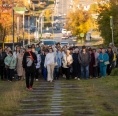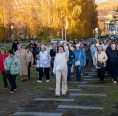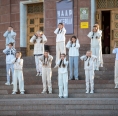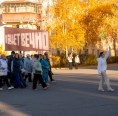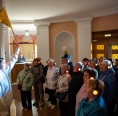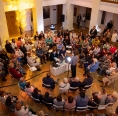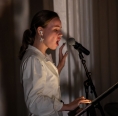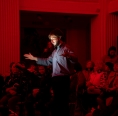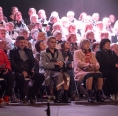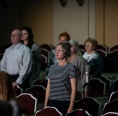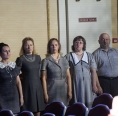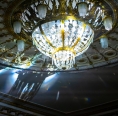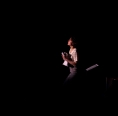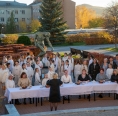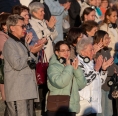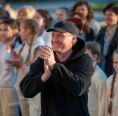-
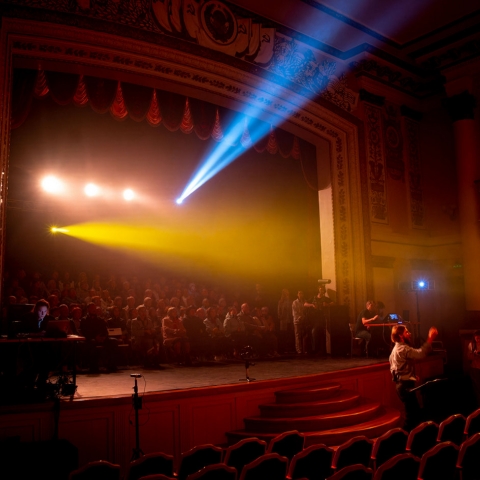
THE PALACE TOOK THE FLOOR
-
Address:
-
Partners:
October 2 saw the first night of the Palace, a performance of the new theater project with participation of Magnezitians. There had to be three performances instead of two since the demand for invitations turned out to be very high, and the number of participants could not be more than a hundred persons per performance due to the specifics of the production. However, the event attracted over 300 spectators.
“I can’t pool over next to the Magnezit Cultural Center. There is an immersion show there tonight!” stated a city minibus driver who was on his public transport route in response to passengers’ requests. Thus, a theater event changed the normal life of the city for a while as well as involving hundreds of residents. Moreover, it certainly changed the attitude to the city’s cultural center – the Magnezit Palace – since those who attended and took part in the performances saw and heard it in a different light. The performance itself became a new word about the place, which is important to the city and popular with the residents.
The organizers of the project had been preparing the spectator for surprises and for an unusual format of the production: the announcements, the posters, the invitations and, finally, the decoration of the palace square and the facade of the building. It was as if everything was saying one thing: “You are in for something extraordinary!”
The performance became an evening walk that started from Kuibysheva Street. But first, the spectators were equipped with immersive headphones. The soundtrack starting with the words “Everything always existed and will always exist” (the banners on the palace square were ‘shouting’, repeating the same words) got people intrigued and, little-by-little, helped them get immersed in the theater performance. The traffic noise, heavy at the end of the working day, disappeared; conversations ceased and we, silent, sometimes smiling, sometimes focusing to understand the story, were moving slowly up the green slope – to the foot of the Palace, which started to talk to every one of its guests, luring them with multiple new episodes.
Gradually, we find ourselves in the foyer of the concert hall and, instead of just watching things from the inside, we become a part of the story that the Palace continues. The center of this episode was the orchestra director and the sound directors, with spectator seats whirling around them. It was like all of us were in the stage director’s seat. There was light flowing from behind our backs, creating astounding highlights and revealing the beauty of the stucco work, the crystal of the chandelier, and the entire magnificence of the majestic building; the flowing fog thickened the time and events in addition to adding mystery to the atmosphere; the sounds of voices were flowing too (from a barely audible breath to a disturbingly loud climax). An entire world and our common history were coming alive. The Palace became its center that concentrates events and the energy of hundreds of people from the past and the present, the memory of everyone who made a dream come true, who created this building, who lives by creating, and who comes to experience all that. The Palace became a heart sounding in the “beat-interval” rhythm. The Palace became life itself.
Another moment and we are on the stage, and before us is a luxurious, mysterious auditorium which takes all our attention. Just a few rows are occupied – by members of the choir who, having transformed in to a “gray mass” are starting their singing, which sounds like a rapid recitative, like a dry political report, then like a slow, prayer-like song, then suddenly like an argument. And the argument is heating up, the argument between the choir and a slim girl in light-colored clothes. It’s Satka played by Liza Navolokina (Chelyabinsk Youth Theater). The third party in the discussion is a voice that belongs to someone we can’t see, but the metallic and monotonous sound of it makes us think of something mechanical, big, tall and authoritative (the idea of the authors of the performance is that it is the voice of the Machine, played by Olga Telyakova, the Honored Artist of the Russian Federation, Youth Theater. – edit.).
The discussion fades away gradually. The choir is listening to Satka, whose thoughts seemed abnormal and naive at first; we hear new words coming out of it: “Peace, calm, beauty, spiritual wealth, freedom, eternity, love!” Everyone wants to dream and have their heads in the clouds, and they are ready to follow Satka – towards the Sun, to harmony, to the “Garden of Eden”. Spectators are leaving the auditorium along with the characters, from the dark – into the bright light whose warmth and buoyancy highlights the “gold” of the autumn part and the sunset that has just began. The final song is on. The text is one of William Shakespeare’s sonnets about the power of friendship and such brittle things as love and beauty, which may sustain and survive time. This closing code that got all the characters of the performance together, like a family around a large table, is the last point of our journey, which is kind and full of light like our dreams and wishes for the future. A point in history, followed by thankful applause and a loud mutual “Thank you!”
“This project became very valuable and even life-changing for me! An incredible event for Satka and for our palace, which “blossomed out” in this production,” says Yelizaveta Navolokina, a Satka-born actress of the Chelyabinsk State Drama Youth Theater. “I’m grateful to the Director Ivan Minevtsev and to everyone in our team. I’d like to thank my family, who also became part of this journey. I learned recently that the birthday of the palace is coming soon, which is wonderful. I attended classes here since my childhood before I went to study in Saint Petersburg. Yesterday, during a rehearsal, as I was waiting for my entrance, I was thinking of how important the place was to me, how huge a role the palace played in my life. And I wanted to thank the palace by my performance, by giving it my emotions, and I felt the response. The palace is my personal power place. All our rehearsals were filled with exploration, discovery and joy. It’s important that all themes played in the Palace are eternal. I’m happy to have been part of this project and a team of like-minded people, so talented and wonderful! I wish Satka and all of us to have more such projects!”
“We are totally bewildered. We expected something unusual, but we still thought we were going to hear a story and see some dancing (our granddaughters are involved in the production). Nothing of the sort!” says Valentina Udavhikhina who came to the performance together with Valentina Mokshantseva. “I have mixed impressions! It’s even hard to describe it right away. It’s the first time we saw something like this. This is quite new to us. We became participants as well as spectators. It was interesting and surprising to come on stage instead of being in the auditorium. And the palace itself is our pride. We love it so much and go there all our lives, to all events, especially when our kids perform!”
FOR INFORMATION:
The new theatrical event took place with the support from the Satka District Development Assistance Fund and Magnezit Group.
The production was created by a team led by the director Ivan Minevtsev: Yekaterina Avgustenyak (playwright), Pavel Larionov (lighting designer), Varvara Ivanik (painter and stage designer), Pavel Polyakov (composer), Ivan Manko (choirmaster and choir director), and Natalya Shurganova (choreographer).
There were over 100 participants involved in the production: members of Satka choirs and dance companies, school pupils, current and retired workers of industrial companies, as well as guest performers and musicians, such as Tamara Kotomenkova (soprano), Olga Vlasova (soprano), Praskovya Krasulya (mezzo soprano), Kristina Popova (mezzo soprano), Maria Alikhanova (bass flute), Danila Zudinov (piano), Grigory Krylov (double bass), Antonina Popras (viola). Mastering: Konstantin Ksenofontov. Supervisor: Maria Dodina.
Source: Magnezitovets. Photo by: Vasily Maksimov
-
26.08 - 26.08
DIARY OF THE THIRD INDUSTRIAL BIENNALE
-
28.11 - 28.11
MY SATKA FESTIVAL WINS THE CONTEST OF CORPORATE VOLUNTEER PROJECTS
-
13.10 - 15.10
COOPERATION WITH VGIBL NAMED AFTER M.I. RUDOMINO

